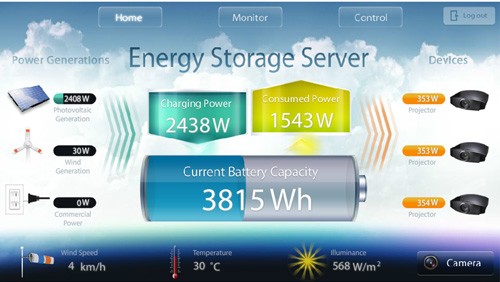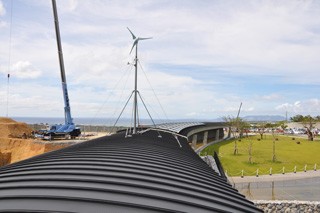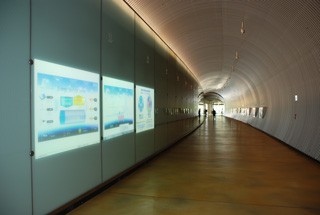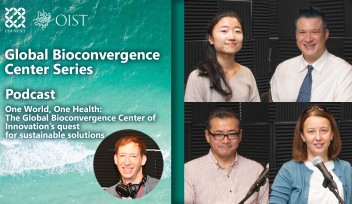OIST & Sony Turn Tunnel into ‘Green’ Audio-Visual Gallery
As you stride along the walkway and tunnel from the car park to the elevators, there is a high chance that you may have noticed the motion sensitive projectors in the tunnel but not the solar panels and windmill positioned on the roof of the walkway.
A collaborative experiment between OIST and Sony Computer Science Laboratories (Sony CSL) is exploring the efficiency and variability of using wind and solar energy.
The windmill and solar panels gather energy which is transferred into specially designed lithium-ion batteries allowing the energy to be stored for long periods. You can watch the results in real time by simply walking down the OIST tunnel, also known as the OIST-gallery. Half way down the tunnel, a screen switches on explaining how much energy is being produced by both the solar panels and the windmill, how much energy is stored in the battery and also the quantity of energy being consumed.

At the moment the energy is being used to power 3 projectors, an internet system and cameras. Sony engineers scrupulously monitor and control the real-time status of the system’s efficiency and performance externally through PCs.
The General Manager at Sony CSL, Mr. Daisuke Yamazaki says, “The use of solar and wind power to generate power is not unique, however, together with OIST we aim to use green energy to charge electric batteries. We are teaming up with OIST as it has offered a site to host the experiment. Sony brings the technology and technical capacity. If this experiment proves successful, the next step is to envisage a system that could eventually power private homes.”
Mr. John Dickison, the Director of OIST’s Facilities and Construction Division comments, “This year-long experiment testing the feasibility and reliability of the solar panels, windmills, storage battery and projectors is a great idea in its early stages. Making use of renewable energy is a plus for OIST and if this experiment is successful, not only will we be cutting costs on electricity but contributing to achieving Okinawa’s 2030 21st Century Vision.” The Okinawa Prefecture is working toward increasing its energy self-sufficiency ratio to 4%, from 0.8%, by year 2030.















